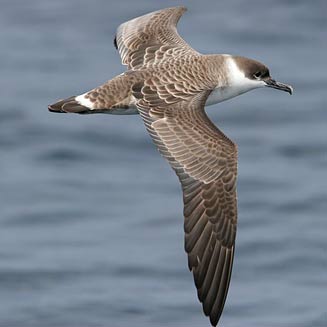
A Great Shearwater on the wing
Paloma Carvalho (Department of Biological Sciences, University of Manitoba, Winnipeg, Canada) and colleagues have published in Ibis International Journal of Avian Science on aspects of the moult of Great Ardenna gravis and Sooty A. grisea Shearwaters
The paper’s abstract follows:
“Moult is an energetically demanding period, during which flight may be impaired and foraging ranges may become constrained. During the non-breeding period, Great Ardenna gravis and Sooty A. grisea Shearwaters migrate from South Atlantic breeding colonies to aggregate at North Atlantic feeding grounds. We investigated whether both shearwater species used coastal Newfoundland, Canada, as a moulting area and used stable isotope ratios (δ15N, δ13C) of recently moulted primary feathers (P1, P5, P10) to infer moult location/diet for both species. Moult scores indicated that both species finished their moult (i.e. P6-10) in coastal Newfoundland, which was further corroborated with similar stable isotope ratios for Great (δ15N = 15.17 ±1.13 ‰; δ13C = -18.66 ± 0.54 ‰) and Sooty Shearwaters (15.54 ±0.74 ‰; -18.43 ± 0.78 ‰); however, Sooty Shearwater moult was more advanced relative to Great Shearwater. In contrast, isotopic ratios of P1 and P5, which were grown before arriving in coastal Newfoundland, differed between and within species, suggesting divergent locations/diet during early moult. For Great Shearwaters, P1/P5 isotopic ratios were more variable (broader niche breadth) than P10, suggesting that some individuals started moulting in the South Atlantic prior to trans-equatorial migration, while others start moulting in the North Atlantic Ocean. Sooty Shearwaters had two distinct groupings of either higher or lower δ15N in P1/P5, suggesting that individuals began moulting either on the Newfoundland Shelf or further offshore based on comparisons to reference shearwater feathers grown in known locations. These findings illustrate distinct locations and/or diets at the start of primary feather moult, both within and between species, but diets converged when aggregated together at the end of moult in coastal North America, where growing feathers of both species were sampled. More importantly, we identified an important area for both Sooty and Great Shearwaters to complete their moult in coastal Newfoundland. Protecting this moulting area would minimize disturbance and the impacts of threats (e.g., by-catch) to both species during this energetically demanding period. The area has been suggested previously to be an important candidate area for protection due to annually persistent prey aggregations that can be spatiotemporally delimited based on specific prey habitat requirements.”
Reference:
Carvalho, P.C., Ronconi, R.A., Bugoni, L., Davoren, G.K. 2022. Moult chronology and strategies of sympatric Great (Ardenna gravis) and Sooty (A. grisea) Shearwaters based on stable isotope janalysis. Ibis International Journal of Avian Science doi:10.1111/ibi.13060.
John Cooper, ACAP Information Officer, 17 March 2022

 Français
Français  English
English  Español
Español